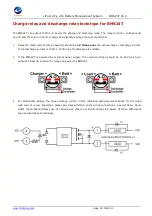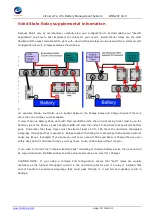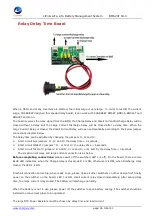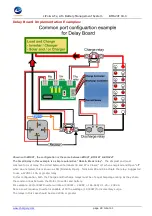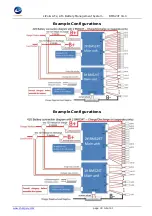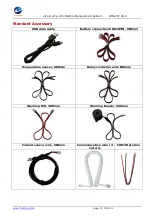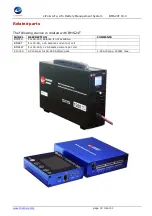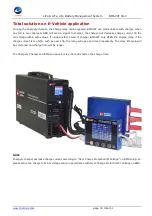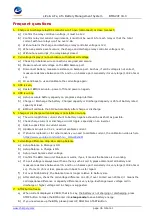
LiPo & LiFe, LiTo Battery Management System BMS24T V4.0
www.chargery.com
page 36 total 41
Frequent questions
1.
Charge or Discharge relay/DC contactor won’t open (disconnect) or close (connect)
a)
Confirm the relay coil driven voltage, it must be 12V.
b)
Confirm relay coil current requirement, it must not be over 1A for each relay or that the total
current with two relays won't be over 2.6A
c)
Without alarm the charge and discharge relay controller voltage is 12V,
d)
When any alarm events occurs, the charge and discharge relay controller voltage is 0V,
e)
Without any warnings, the relay always closed
2.
Cell voltage display is not accordance with actual cell voltage
a)
Check 9 pin balance wire connections are good and secure.
b)
Measure actual cell voltage on the BMS balance port.
c)
Disconnect battery, measure resistance on balance port. Such as, if cell 5 voltage is not correct,
measure resistance between cell 5- and 5+ on balance port. Generally it is very large (100K ohm or
so).
d)
Or send back to us and calibrate the cell voltage again.
3.
SOC is zero,
a)
Restart BMS main unit---power off it and power on again.
4.
SOC is wrong
a)
Setup accurate battery capacity on program setup interface
b)
Charge or Discharge the battery. Charged capacity or Discharged capacity is 25% of battery rated
capacity at least.
c)
BMS will calibrate the SOC automatically after charge or discharge.
5.
Charge or discharge current display is not stable or wrong
a)
The wire length from current shunt to battery negative should be as short as possible.
b)
Check charge current or discharge current ripple, especially on an inverter.
c)
Add low-pass filter on current sensor
d)
Update main unit to V1.21, need not calibrate current.
e)
If shunt is replaced, or for other reasons you need to calibrate current, the calibration video is here
https://www.youtube.com/watch?v=_LOJw83s18M
6.
Cell voltage difference drop slow during balance
a)
Setup balance in Storage is ON
b)
Setup balance in Charge is ON
c)
Setup lower balance start voltage
d)
Confirm the BMS main unit blue case is warm, if yes, it means the balance is in working.
e)
If a cell voltage is always lower than others, such as cell 5, please disconnect all battery and
measure resistance between cell 5- and 5+ on balance port. Generally it is very large (100K ohm or
so). If only 10 ohm or less, please return back to us for repair.
f)
For over 50Ah battery, the balance time is longer relative to battery size
g)
After discharge, check the cell voltage difference on LCD, if over 100mV even 200mV, it means the
cell impedance difference or capacity difference is very large. Exchange lower voltage cell in
discharge or higher voltage cell in charge is suggested.
7.
STOP button freeze
a)
When current displayed is ZERO, that is to say, the battery is not charging or discharging, press
STOP button to make the BMS enter into
sleep mode
to save battery energy.
b)
If you need wake up the BMS, please press UP, DOWN or START Button.



